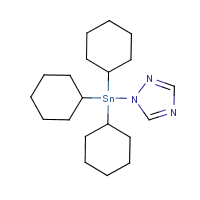Azocyclotin
Agent Name
Azocyclotin
CAS Number
41083-11-8
Formula
C20-H35-N3-Sn
Major Category
Metals

Synonyms
(1H-1,2,4-Triazolyl)tricyclohexylstannane; 1-(Tricyclohexylstannyl)-1H-1,2,4-triazole; BAY BUE 1452; Peropal; Tri(cyclohexyl)-1H-1,2,4-triazol-1-yltin; Tri(cyklohexyl)-1H-1,2,4-triazol-1-ylstannium [Czech]; Stannane, (1H-1,2,4-triazol-1-yl)tricyclohexyl-; [ChemIDplus] UN3146
Category
Tin Compounds, Organic
Description
Colorless solid; [HSDB]
Sources/Uses
Used as a long lasting acaricide on fruit (including citrus), vines, hops, cotton, vegetables, and ornamentals; Not registered for use in the US; [HSDB]
Comments
A strong skin and eye irritant, based on animal studies; [HSDB] A skin and respiratory tract irritant; May cause severe damage to eyes; [eChemPortal: ESIS] Rapidly hydrolyzed to cyhexatin and 1,2,4-triazole in aqueous solution; In high-dose animal studies, causes spastic gait, diarrhea, and apathy; Corrosive to rabbit skin; At doses >2 mg/kg/day causes miscellaneous adverse effects in animals, including elevated liver enzymes; Unlikely to be genotoxic; [Reference #1] See "Cyhexatin." See "1,2,4-Triazole."
Reference Link #1
Biomedical References
Exposure Assessment
Skin Designation (ACGIH)
Yes
TLV (ACGIH)
0.1 mg/m3, as Sn
STEL (ACGIH)
0.2 mg/m3, as Sn
PEL (OSHA)
0.1 mg/m3, as Sn
MAK
0.1 mg/m3, inhalable fraction, as Sn
IDLH (NIOSH)
25 mg/m3, as Sn
Vapor Pressure
4.5E-13 mm Hg
Lethal Concentration
LC50 (rat) = 17 mg/m3/4h
Explanatory Notes
The Guide in the Emergency Response Guidebook is for "Organotin compound, solid, n.o.s." Organic tin compounds have a "skin" designation and are classified as "A4" (Not classifiable as human carcinogen); [ACGIH]
Adverse Effects
Neurotoxin
Other CNS neurotoxin
Hepatotoxin
Hepatoxic (a) from occupational exposure (secondary effect) or (b) in animal studies or in humans after ingestion
Dermatotoxin
Skin burns
ACGIH Carcinogen
Not Classifiable
Diseases, Processes, and Activities Linked to This Agent
Processes
Industrial Processes with risk of exposure: